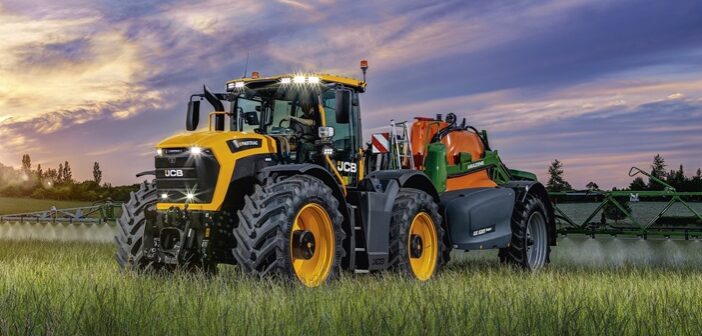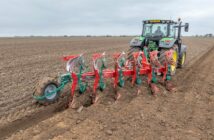JCB has launched new versions of its Fastrac 6000 series, the 6260 and 6300, offering 284hp and 335hp respectively.
The two models both run on 38in or 34in rims all round and 600mm to 710mm-wide tyres, with selectable two- and multi-mode four-wheel steering as standard.
Housed in a new chassis concept bringing together a front casting and fabricated steel rear section, a 6.7-litre FPT six-cylinder engine delivers peak power at 1,850rpm alongside a torque curve that rises under heavy load to peak at 1,400rpm, generating 1,275Nm torque for the Fastrac 6260 and 1,400Nm for the 6300.
A power-matched ZF Eccom 3.1 stepless transmission delivers seamless speed changes with a high proportion of mechanical drive efficiency at key field and transport speeds, with JCB’s Smart Transmission Control ensuring optimum control for different applications.
The heavy-duty chassis casting is sculpted to allow the tightest possible front axle steer angle, and is pre-prepared to easily fit front loader brackets, while the engine installation is as narrow as feasible to offer the best possible view from the cab
Upgraded hydraulics
High output variable-flow hydraulics cater for modern implements with a 205 litre/min pump as standard, plus a second pump option for a total of 410 litre/min for the Fastrac 6300, all supplied through a new hydraulic valve block with lever-operated push-out, pull-in couplings.
At the rear, an 11,000kg three-point linkage – attached to the back axle to retain full suspension movement under load – and four-speed power-take off cater for all implement types, while the optional 5,000kg lift front linkage is complemented by a 1,000rpm power take-off with the new feature of a six-spline and 21-spline reversible shaft.
The 5,000kg capacity load deck provides a third mounting location for equipment such as a sprayer or a liquid tank supplying fertiliser.
A new brake pad wear indicator helps operators avoid the risk of worn pads and the new hub-mounted discs are quicker and easier to replace, with the company claiming it can be done in as little as three hours.
An improved steering system provides smoother and more progressive transition between conventional two-wheel steer and the multiple four-wheel steering modes available at low speeds on the road and for different field applications.
An optional Twin Steer system available through JCB GPS controls the two axles individually, so the tractor can steer crab-wise directly to a field guidance wayline at a headland or if a correction is needed to keep an implement on track, especially across sloping ground.
JCB claims the system is highly effective at maintaining accurately spaced and positioned rows when sowing high-value vegetable and salad crops grown in beds, and at eliminating damage to crops or beds during multi-pass operations.
The JCB iCON display can now be complemented by a second unit so that more information is visible at any time.
Digital enhancements
Operators can also populate the display with the content of their choice – such as guidance, camera view, isobus and section control. Also, multiple control set-ups can be created, including tractor and implement settings for quick recall when next carrying out the same operation.
JCB LiveLink telematics provides remote tractor monitoring and records, and optional isobus electronic implement control and facilitate precision farming technology.
The factory-installed satellite guidance option has two NovAtel satellite signal receivers as standard, for even greater accuracy. ln addition to straight-line and curve guidance, the system now provides a choice of headland turn pathways to increase ease of use through automation, and boost overall productivity.


